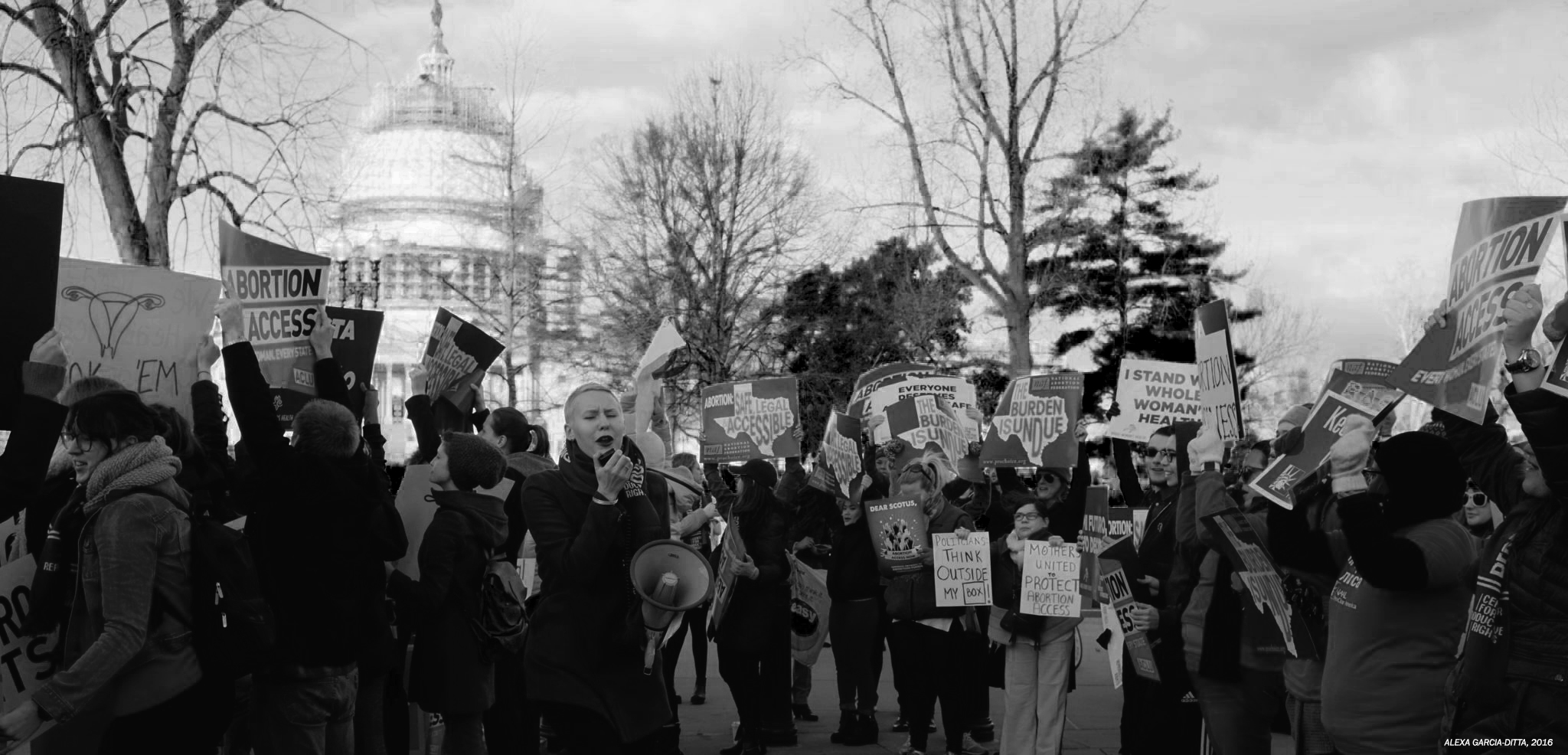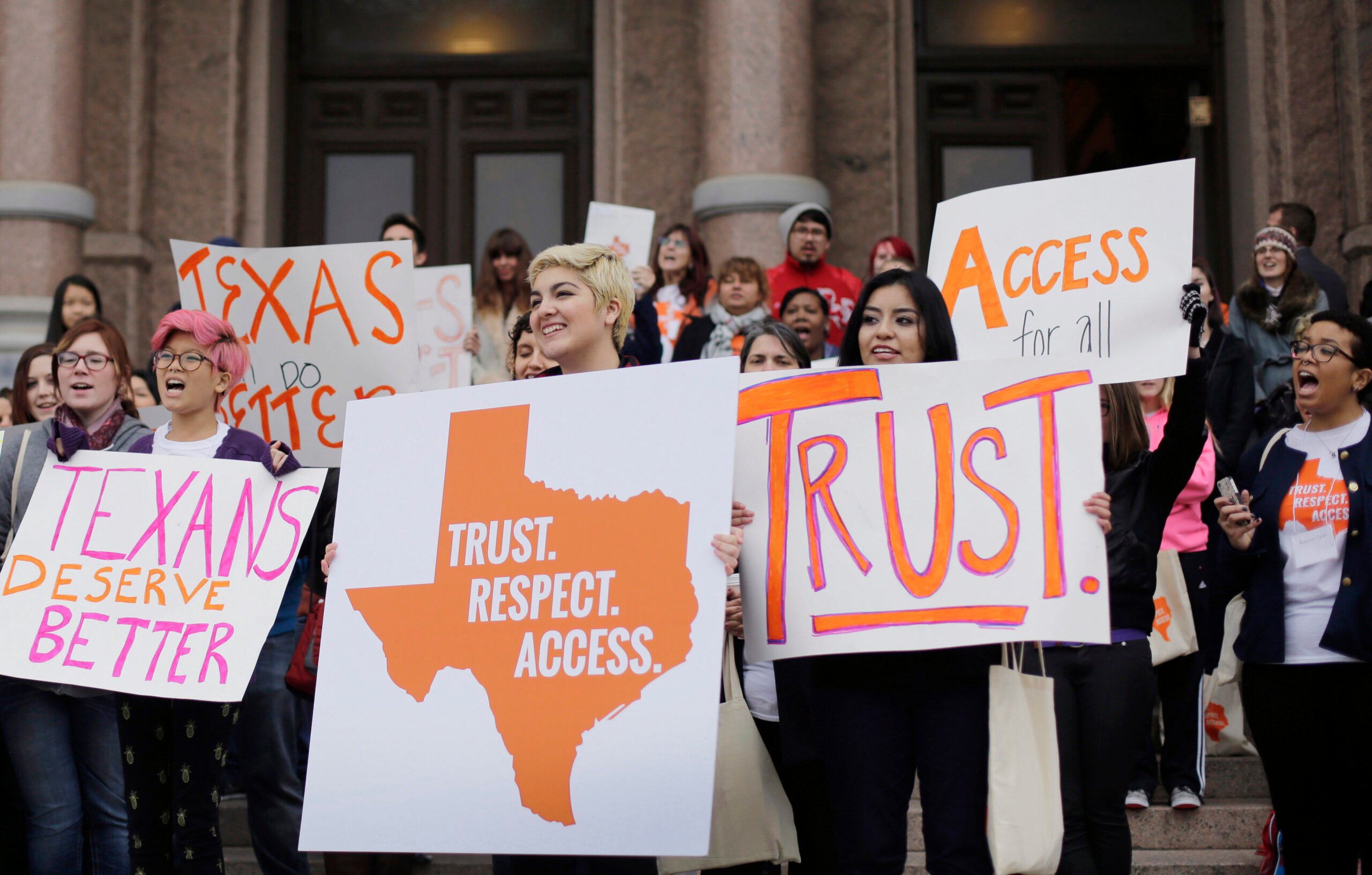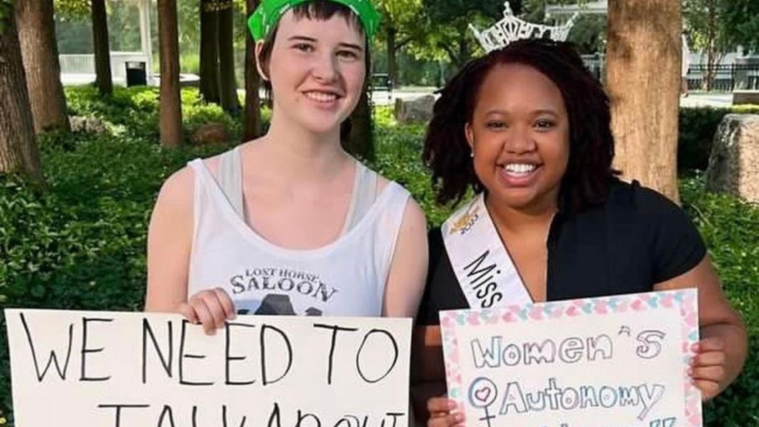
Molly Ivins on Roe v. Wade
With President Trump set to nominate another conservative justice to the U.S. Supreme Court, abortion-rights activists worry about the future of Roe v. Wade. Molly Ivins wrote this piece in the aftermath of the 1973 landmark ruling establishing a woman's right to abortion.
Molly Ivins on Roe v. Wade
Molly Ivins wrote this piece in the aftermath of the 1973 landmark ruling establishing a woman’s right to abortion.
–
February 16, 1973
by Molly Ivins
The decision came down the day Lyndon Johnson died and the impending peace in Vietnam topped even that story. It was not what you call your slow news day, so the impact was muted. But it was not just the timing — even those who have fought for, worked for and believed most deeply in the reform of our abortion laws did not feel like celebrating. There was one report of a party in the San Francisco office of the National Organization of Women, but for many feminists it just didn’t seem like a champagne occasion. It was a little like the end of the war — more relief than joy. Sarah Weddington said calmly that she was “pleased, very pleased.” She is the Texas lawyer who won the case.
One way to look at the struggle over abortion is the journalist’s way, sifting slowly through the clips, most of them yellow and brittle with age. Story after story is added to the big heap — the legal maneuverings year after year; the legislative reform efforts year after year; the obligatory “balanced” series from the women’s sections, some good, some poor; the case histories, all that terror and misery reduced to 10 inches of type; the brief death notices; the statistics stories, the opinion polls; the gory ads from the Right to Life groups; the Catholic papers, arguing again and again that that their position is not based on religious doctrine; doctors under indictment; the Florida woman convicted of manslaughter because she got an abortion; the slow changes, the medical association votes in favor of reform, the mental health organization votes in favor of reform, a legislator speaks out, a good government group; more deaths, more statistics, more polls.
–
ABORTION HAS been one of the messiest issues. Issues get to be messy not because reasonable folk disagree about them, but because irrational emotionalism infects them. And during the last 20, 30, 40, 50 years of public discussion of abortion, both sides have always seen the question, finally, as one of Right Against Wrong. This has been true of the abortion debate to a far greater extent than it is of public debates on such simple topics as defense posture, welfare reform, campaign spending and the like. For example, who could ever forget the Solid Rock League? For those of you who have never had a chance to forget them, it should be noted that the Solid Rock League of Women of Houston is against genocide or child slaughter. The Solid Rockers also oppose common-law marriages for teenagers, pornography and “the taking away of religious freedom while atheism is being allowed in the schools.” (One of the chief Solid Rockers once went to Pacifica radio station in Houston to tape a discussion program. She appeared accompanied by two hired male bodyguards, one of whom sported a Canadian Mounties-type outfit with both a gun and a hunting knife in his belt. While the Rocker was doing the program the Mounty confided to a Pacifica staffer, “This isn’t the strangest assignment I’ve ever had: I was once asked to guard a barrel of pickles for 24 hours.”)
What between all those aborted feti dumped into buckets whilst still alive and all those 14-year-old girls with rusty hangers stuck up ’em, anyone who kept his head clearly did not understand the situation.
Fortunately, perhaps, for all of us, abortion eventually came down to a question not of Right or Wrong but merely whether it was constitutional. The decision was seven to two out of the Nixon Court, which reassures everyone except those who now want to excommunicate Justice Brennan and hang the other six. Right to Life! The Court’s decision was based on (God bless us) Texas law. The case is styled Roe v. Wade.
Jane Roe is the pseudonym of a young Dallas woman, unmarried, who got pregnant but who could not afford to leave the state to get an abortion. She has since had the child. Wade is Henry Wade, the Dallas district attorney. The heart of the Supreme Court’s decision was based on Roe v. Wade; the Court also decided some peripheral matters concerning abortion in the Georgia case heard along with Roe v. Wade, styled Roe v. Bolton. Roe v. Wade was first argued in May, 1970, before a three-judge federal panel in Dallas. It was heard in conjunction with Doe v. Wade. John and Mary Doe are a Dallas couple: she suffers from a neural-chemical disorder and had been told by doctors that she could not (A) take birth control pills or (B) get pregnant. Roe and the Does filed suit in March of 1970 and were later joined in their suit by James H. Hallford, a Dallas doctor who had two criminal abortion suits pending against him. Roe and the Does were represented by Linda Coffey and Weddington while Hanford was represented by Fred Bruner.
Coffee told the judges that abortion is “a fundamental human freedom.” Weddington argued that the state should not regulate when an abortion should be done, but only that it be done by competent, licensed personnel. Bruner said the law was unconstitutionally vague. To the layman, nothing could have been clearer than Texas’ late abortion statute: it permitted abortions only in order to save the life of the mother: unless it would literally, physically, immediately kill a woman to have a child, she was statutorily bound to have it — whether or not the child was deformed, idiotic, the product of incest or of rape; whether or not it would cripple the woman physically or emotionally to have the child; whether or not she could afford to care for and rear the child; whether or not it would wreck her marriage; whether or not the child meant an impossible additional financial burden to a family . . . and on and on. The Right to Life argument was singularly ill-founded, legally, not because it failed to address itself to the question of whether a child has a right to a minimally decent life (pro abortion-reform advocates have sometimes effectively used the horrifying statistics on battered children) but because the reason for abortion statutes in the first place was to protect the right to life of the mother, not of the child. As Justice Harry Blackmun noted in his decision, abortion statutes are of relatively recent vintage —late 19th century — and they were passed to protect women, not unborn children. Abortion was then an appallingly hazardous operation. But for years it has been, when done in “a clean, well-lighted place,” about as dangerous as a tonsillectomy. Even more recent technological advances, particularly the suction method, which is about two years old, have made abortion, in the early stages of pregnancy, somewhat more serious than getting your ears pierced. This is not to minimize the sometimes grave psyhological consequences of what is now a minor medical operation.
On June 17, 1970, Circuit Judge Irving Goldberg, Fifth Circuit Court of Appeals, and U.S. District Judges Sarah T. Hughes and William Taylor, Jr., issued a declaratory judgment as a result of Roe, Doe and Hallford. They declared the Texas abortion statute unconstitutional; however, they refused to grant an injunction against the prosecution of Hallford and other doctors similarly indicted. As a result, the status quo prior to their ruling remained in effect. Wade promptly announced his intention to continue prosecuting under the state law and Texas doctors didn’t appear to be any more willing to perform abortions than they had been before the ruling. The plaintiffs appealed directly to the Supreme Court both for injunctive relief and for a decision on the constitutionality of the Texas statute.
–
ON DEC. 13, 1971, Roe v. Wade was argued for the first time before the Supreme Court, before Justices Rehnquist and Powell had been appointed by Nixon. Despite the fact that the attorneys had asked for more time than is usually granted by the Court, on the grounds of the importance of the issue, the hearing was limited to one hour: 30 minutes for each side. Weddington argued the case on the grounds of the Ninth and Fourteenth Amendments. Jay Floyd, assistant Texas district attorney, argued that the case was moot since by that time Roe had already had her child. Justice Potter Stewart noted that “This is a class action suit and I think we can take judicial notice that at any given time there are unmarried, pregnant women in Texas.”
Floyd then argued that the courts could not give a woman judicial relief from the law. “I think a woman makes her choice prior to the time she becomes pregnant and she can’t make a later choice not to have the baby.”
Stewart noted that “The Texas law doesn’t permit abortions in the case of rape and I don’t believe the woman makes her choice before pregnancy there. Maybe she makes her choice when she decides to live in Texas.”
The case was argued a second time before the full nine-man court in October 1972, again in conjunction with Bolton v. Wade. According to stories published in the Eastern press at the time, there was some infighting on the Court between the first and second hearings of the case. By tradition, the chief justice selects the man who is to write the Court’s opinion if the chief justice is on the majority side. If he is not, the senior justice on the majority side decides who will write the opinion. Chief Justice Burger was not, reportedly, on the majority side originally, but he nevertheless insisted that Blackmun, his longtime friend from Minnesota, write the opinion. Justice William Douglas, who would have been the senior justice on the majority side, objected vehemently. It was apparently at Burger’s instigation that the court waited and then re-heard the case.
Despite the brevity of the arguments, the court had a good deal of material to go through: seven women’s organizations and 47 women filed friend-of-the-court briefs. Among the organizations were N.O.W., the Y.W.C.A. and the American Association of University Women. Among the individuals were Margaret Mead, anthropologist, Marian Javits, wife of the New York senator, Maureen Neuberger, senator from Oregon, Mary Lindsay, wife of the New York mayor, Harriet Van Home, columnist, and Bess Myerson, consumer affairs commissioner of New York City.
On Jan. 22, the Court declared both the Texas statute and the more liberal Georgia statute unconstitutional. Blackmun, who wrote the decision, said, “We need not resolve the difficult question of when life begins. When those trained in the respective disciplines of medicine, philosophy and theology are unable to arrive at any consensus, the judiciary, at this point in the development of man’s knowledge, is not in a position to speculate as to the answer.”
Blackmun did find, however, that although the Constitution does not explicitly mention any right of privacy, the Court, in a line of decisions, has recognized that a right of personal privacy does exist under the Constitution. “This right of privacy . . . is broad enough to encompass a woman’s decision whether or not to terminate her pregnancy.”
–
BUT, in a development entirely unlooked for by the lawyers in the case, the Court saw fit, in a refinement worthy of Solomon, to find different constitutional implications depending on the duration of a pregnancy. During the first three months, said the court, the mother’s right to privacy supersedes all else. But during the second three months, the state’s important interest in safeguarding health, in maintaining medical standards and in protecting potential life may be properly asserted “to the extent that the regulation reasonably relates to the preservation and protection of maternal health.” The state’s “important and legitimate interest in protecting potential life,” said the court, becomes “compelling” at the point of viability, i.e., during the last three months of pregnancy, . . . the state may go so far as to proscribe abortion during that period except when it is necessary to preserve the life or health of the mother.”
This tripartite approach to pregnancy is a judicial originality. There has been some mention of “cut-off” points in previous decisions — for example, the state of New York fixed on the 24th week because many fetal deformities cannot be detected until that point. But the three-stage decision, like Nixon’s economic program, seems as much a response to pragmatic considerations as one of adherence to principle.
Weddington, who had thought she would either win or lose the case by a one-vote margin, is now convinced that the best course for the states is to do nothing at all. She will presumably have some influence in this area since she is a member of the Texas House of Representatives. At last check, no legislator had introduced any abortion legislation, although there were rumors that there might be some. But in fact, most politicians dislike nothing more than having to vote on such things — there is no way they can come out without losing support. Many of them not only dread the prospect, they have a positive phobia about it.
Weddington herself is something rather special. Although she feels she was not able to relate well to the Solid Rock League, if one can feature any abortion reformer ever getting along with that group, it would be Weddington. She is, to use an old-fashioned term frowned on by Women’s Lib, a lady, a perfect lady. She is grave, graceful and composed. “It’s not that Sarah doesn’t have a sense of humor,” said Ann Richards, an Austin housewife who was part of Weddington’s campaign braintrust. “It’s just that you gotta prep her a little. You say, ‘Now, Sarah, I’m about to tell you a funny story,’ and then she’ll just laugh and enjoy it as much as anyone. But you gotta warn her first, because it just doesn’t occur to her that someone might throw in a joke in the middle of serious business.”
–
WEDDINGTON was recently mousetrapped in this regard by that nefarious jokester Cactus Pryor, who was preparing his annual spoof for the Headliners Club. Weddington, along with several dames of importance, was invited to pass preview judgment on a proposed new addition to a well-known Austin restaurant. The women were told that the restaurateur planned to open a Women’s Only section featuring topless waiters, two of whom then appeared and showed their impressive torsos to the group. Most of the other political wives in the group got off with a noncommittal, “Oh, my, my” reaction. But ol’ Sarah gravely launched into a lecture to the restaurateur, assuring him that while she meant no insult to these very nice-looking young men, nevertheless, she had never approved of Men Only sections and . . . The episode was being filmed for use at the Headliners.
Weddington has a unique family background for a small-town Texas girl. Her daddy has a Ph.D. and her mother a master’s. Her father, for many years a Methodist preacher in a series of small Texas towns, is now head of the Methodist youth program for this state. Weddington skipped a couple of grades of public school and so graduated from McMurray College in Abilene, magna cum laude, at the age of 19. She was certified to teach high school English and speech, but her practice teaching sessions convinced her that she wasn’t cut out to be a teacher. She looked around, and because higher education was an accepted thing in her family, had no hesitation about entering law school, which she finished at about the age most students complete their undergraduate work. She became interested in the Women’s Movement during her senior year in law school. She practiced briefly in Fort Worth and came back to Austin to open a practice with her husband Ron. Ron Weddington, who is also from Abilene, had spent several years in the service and so graduated from law school a few years after Sarah.
According to law school friends, Ron was the outgoing, social Weddington, while Sarah’s natural reserve and relative unsophistication made her a quieter, less party-going type. “I had never even been to a party where liquor was served until after I graduated from college,” said the minister’s daughter. On one famous occasion, she got annoyed with Ron and decided to “show him.” She forthwith got extremely drunk and subsequently quite sick. “I don’t think you even noticed,” she said to her husband with some asperity. “Not notice?!” protested Ron. “Hell, honey, I had to pour you into the car.” Weddington (Sarah) has not since been known to overindulge.
–
WEDDINGTON and her law school classmate Linda Coffee started doing spadework on Texas’ abortion law as a result of their interest in feminism. When Jane Roe came to Coffee, Weddington volunteered to serve as co-counsel. The James Madison Constitutional Law Institute of New York helped with some of the expenses. Weddington wound up doing the oral arguments before the Supreme Court mostly, she says, because Coffee had joined a Dallas law firm and didn’t have much time to devote to the case. Weddington had worked on it all summer. Ron Weddington observed, “Sarah feels uncomfortable if she doesn’t know absolutely everything about every single angle of any case she’s working on. Hell, I’ve tried to tell her, a lot of lawyers really don’t know what they’re doing when they go into court. But you can’t make Sarah relax about it.”
Weddington had attended some sessions of the Women’s Political Caucus and finally decided that the only way women were ever going to get any experience in politics above the stamp-licking level was to try it themselves. So she pinned up her long, red-blonde hair in an effort to look more respectable and went down and filed for the Legislature. “At the beginning, I never thought I would win,” she said.
“Hell,” said Ann Richards, “I never thought she would lose.”
Sarah had first a dedicated hard-corps, then a whole troop and finally almost an army of women out working for her. Many of the women had worked in politics for years, making coffee, addressing envelopes, and being carefully excluded from all decision-making. But they had picked up ideas and expertise they were anxious to try out. Richards, who had worked in the North Dallas Women’s Club, Linda Anderson, whose husband Jamie worked in Sissy Farenthold’s campaign, Caryl Yontz, who had been with Yarborough’s P.R. people, and a legion more of very bright women who had wanted to get involved in politics but who had been turned off by the low-level jobs available in men’s campaigns. Weddington’s campaign was a slightly chaotic attempt at participatory democracy: it took more time and more effort, but even the lowly stamp-lickers were in on the decisions. The only male in the braintrust was Ron, who eventually left Farenthold’s campaign to sit in on this interesting thing his wife, of all people, had going. He handled the media work.
–
THEY RAISED money by giving parties. They had beer and chili ’til it ran out of their ears. Ron couldn’t believe the girls were mad because they had raised “only” $300 or $400 at the first party. “For a local campaign, with no big press job!” he gasped. But they thought they could do better.
At the big Travis County Democratic Fair fundraiser in the spring of ’72, Weddington knew her opponent would be handing out expensive favors, flashy gizmos dreamed up by professional political P.R. types. Ann Richards gnawed her nails for a few days over that and finally thought, “Well, when they pick up all this junk from the other candidates, they’ll need something to carry it in.” So for 13 bucks they acquired a couple hundred shopping bags and stuck Weddington stickers on them so everyone else’s expensive favors went into Weddington’s tote bags.
Richards, who has never been short on brass, decided that the best thing to do with Sarah was to trot her around and introduce her to everyone who would logically oppose her. “We did this Laurel and Hardy routine,” said Richards. “I’d go in to jolly ’em up and break the ice and then Sarah would come on all soft and reserved and ladylike. She’d ask for advice and listen to it. She’s a great listener. Then people felt they had a stake in her. During the runoff, the Alarmed Citizens of Austin had her on their bad list. We called them the Alarmed Dingalings.”
Cactus Pryor observes that the Alarmed Citizens consisted mostly of Sam Wood, editor of the Austin American-Statesman, charging up and down Congress Avenue on a horse screaming, “The students are coming! The students are coming!”
Richards, nothing daunted, marched Weddington off to meet Sam Wood. Wood told her he had read, as he was sure everyone had, that blacks regarded abortion as a racist plot to lower or wipe out the black population. Didn’t she think her advocacy of abortion might hurt her in the black precincts? “Why, I’ve heard that too, Mr. Wood,” said Weddington sweetly. “But, you know, the funny thing is that I’ve only heard it from black men.”
And so they persevered, that group of women who turned out to know so much about politics. And they won. Weddington gives all the credit to her crew of women and the women give all the credit to Weddington and it’s a downright rose festival, it is. But Weddington, who is not what you could call a real politician, is at least too smart to turn loose of her ladies. She’s got them volunteering right and left, at her citizens’ information center, sitting in on committee meetings she can’t make, and here and there and everywhere. She’s got three big plummy, juicy committee assignments and, in typical Weddington fashion, instead of rejoicing over her power she’s worrying about whether she can handle it. The women who work for her have no doubts at all.
-M.I.


